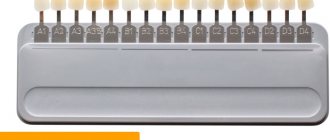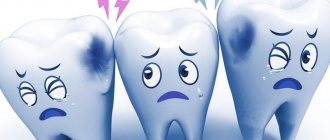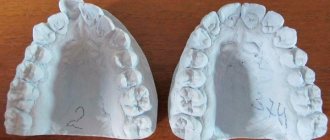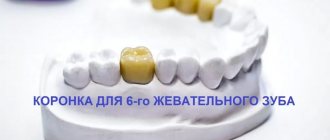Natural color is milky white, slightly translucent. If the teeth are snow-white, the dentist has intervened; such tones are not present from birth. The shade depends on dentin and enamel. In a person's youth, the enamel layer is stronger. The dentition looks whiter if the enamel layer is dense and does not allow light to pass through. This is achieved by removing irregularities.
With age, teeth wear down, the surface becomes smoother, light passes through more easily, which makes the image dimmer. The enamel becomes brown, yellow, black or gray. Different parts of the structure have different colors. A light shade predominates on top, a dark shade on the bottom. But each person has his own natural tone - this is normal.
Author of the article: Shirokov Ivan Yurievich
Work experience:
15 years
Specialization:
Dentist-orthopedist
Works:
at the clinic on Butyrskaya metro station
What color is considered normal for a milk bite?
Baby or primary teeth in children are usually whiter than permanent teeth in adults. This color comes from thinner enamel than permanent crowns. If the milk crowns have a yellowish or grayish tint, then this indicates their disease or a metabolic disorder in the body.
The method of returning the natural shade to temporary units depends on the reasons for its change. Sometimes it is enough to exclude certain foods from the diet and start filtering the water, and the color of the crowns will gradually be restored. If the change in enamel color is caused by a disease, then it is important to establish a diagnosis and select adequate treatment.
Reviews
Has your dentist used the Vita scale? Was the selection of the shade accurate, and were your expectations met?
You can also tell us if you have had experience with professional or home whitening. Were you satisfied with the result? You can leave answers to these questions, reviews and your opinion under the article.
If you find an error, please select a piece of text and press Ctrl+Enter.
Tags diagnostics teeth whitening
Did you like the article? stay tuned
Previous article
Features of restoration of the contact point during tooth reconstruction
Next article
Treatment tactics for dental trauma depending on the degree of destruction
Reasons for changes in enamel color in children
- Some diseases of a pregnant woman: viral or bacterial infections of the mother’s body, as well as some medications (for example, tetracycline antibiotics) leave an imprint on the development of the fetus, including the formation of its tooth buds. This is fraught with the fact that the baby will erupt in units already with a defect (enamel hypoplasia or hyperplasia, tetracycline teeth, etc.),
- initial stage of caries: may change the color of milk crowns (white spots appear on them),
- fluorosis: a surplus of fluoride in a child’s body (due to the large consumption of fluoride-containing products, water, the use of toothpaste with a high content of this element) changes the color of the enamel, it becomes grayer and at the same time rough, brittle, with grooves,
- treatment with iron preparations: if they are used in liquid form, they cause temporary darkening of the tooth surface,
- constant consumption of coloring products: blueberries, bird cherry, sweets and drinks with artificial colors or based on red and blue berries.
Diagnostic methods
The most important method for diagnosing discoloration is visual examination and collection of information about the condition of the body as a whole. To assess the internal condition of the teeth, radiography . To obtain more accurate information about structural changes in tissues, digital technologies are used. An orthopantomograph is a device that helps to view the dentition on a computer screen with high resolution from different angles. The role of this study is especially important during therapy, to monitor the correctness of the chosen course. Another highly informative method for diagnosing pigmentation is microscopy . It allows you to enlarge the object under study tens of times and examine the area of pathology extremely closely.
Reasons for changes in tooth shade in adults
- violation of the rules of brushing teeth at home: irregularity, unsuitable toothpaste or brush,
- hereditary reasons
- the richness of the daily menu with pigmented products: black berries, strong black and red tea, coffee without milk, red wine, ketchup, soy sauce, etc.,
- smoking: gives a yellow or even gray-yellow coating,
- With age, dentin darkens and enamel becomes thinner: therefore, crowns acquire a darker shade than in youth - due to translucent dentin. Thinning of the enamel due to metabolic disorders also leads to a change in the color of the unit, because dentin is naturally yellow,
- deficiency or surplus of certain vitamins or microelements: zinc, fluorine, iron in the body,
- the presence of an old filling: often its elements penetrate into the dentin over time, oxidize and color it gray or red, which affects the external shade,
- microrelief of the crown surface: the more pronounced it is (grooves, pits, roughness), the darker the crowns appear.
Attention! After professional teeth cleaning (without bleaching), crowns may become a shade or even two lighter. This happens because the hygienist removes plaque, which gives a darker color, grinds and polishes the teeth, leveling the microrelief.
Scope of application of the Vita scale
Using a basic color chart, the dentist can identify the “native” shade of a person’s teeth or detect, if any, possible color defects. The fact is that the same tooth color looks different in people with different skin colors. For example, an unpleasant yellow tint is masked if a person returns from vacation very tanned, and then his smile appears white. However, the Vita scale helps to adequately assess the clinical picture. Such a tool is important in several dental fields.
The Vita scale is often used in the following situations:
- professional teeth cleaning with ultrasound and Air-flow: after ridding the patient of plaque, the hygienist must make sure that he has restored the natural color of the crowns. In addition, the Vita scale can be used before the procedure to conduct a comparative analysis of the effect of tartar on the color of crowns and to develop an individual oral care program for a particular person (this may include both nutritional correction and the cessation of bad habits, the use of certain brands of dental pastes and even brushes),
- for whitening in the clinic: laser, intracanal, photo bleaching, chemical bleaching. The doctor needs the palette to determine how many shades the enamel needs to be whitened, whether the result will look unnatural and whether it will lead to negative consequences, especially if the patient wants a snow-white smile, but the condition of his crowns does not allow him to achieve such a shade. In addition, during the procedure, the doctor should check the result so as not to overdo it,
- dental restoration: in the presence of chips, cracks and other surface defects, it is important that the filling, crown or microprosthesis are not noticeable on natural dental tissues.
Determination technique
The scale was created to facilitate the work of the dentist and create an aesthetic appearance of the elements of the jaw rows after the procedures.
What difficulties do you encounter when choosing a shade? As it turned out, a number of factors hinder the accuracy of choice.
Creating conditions
The wrong shade can be selected both due to the fault of the doctor and the fault of the patient. To eliminate complications on the part of the client, it would be useful to warn the doctor about some mistakes:
- It is advisable to wear soft, pastel-colored clothing for the reception;
- women are not recommended to wear flashy makeup, and especially not to use dark or bright lipstick;
- hair is pulled away from the face.
Factors influencing perception
The reasons why the doctor chooses the wrong shade are as follows:
- the walls of the office are painted with dark or bright paint;
- there is no lamp with adjusted lighting intensity;
- in the absence of artificial lighting, which was mentioned above, the appointment is scheduled for the evening, when the sun's rays are unable to help with the choice.
- rubber dam on the treated surface can also distort visual perception;
- human factor, such as fatigue of the dentist if the appointment is scheduled for the evening.
How is the Vita scale used?
All the previously mentioned reasons must be taken into account by the dentist when a patient comes to him who needs treatment or cosmetic restoration of crowns. In all these cases, the doctor must focus on the natural appearance of the enamel in order to select the filling material of the desired shade or install veneers. For this, doctors use the Vita scale.
It is represented by a kind of palette, divided into quarters (sectors), designated by indices A, B, C and D. Each sector has several subtones, and thus the doctor has the ability to operate with 16 shades. This allows you to correctly correct the color during treatment or prosthetics. In addition, the patient himself can compare and choose the shade that seems most natural and acceptable to him.
Interesting! The Vita scale is usually made of laminated cardboard, plastic or thick paper, but professionals use a movable table with painted acrylic or ceramic overlays. This device is convenient to apply to the teeth, comparing and adjusting shades. The basic table produced by Ivoclar Vivadent (Liechtenstein) has good reviews from doctors all over the world. Its slats include the lightest shades (Bleach) of groups A, B, C and D. This palette costs 1,400 rubles.
In modern dentistry, all possible shades of enamel are usually divided into 4 groups:
- group A: reddish with a brownish bias, includes the five most popular shades - A1, A2, A3, A3.5 and A4,
- group B: red with a yellow bias. Includes 4 semitones from B1 to B4,
- group C: gray shades. This also includes 4 semitones - from C1 to C4,
- group D: red with a gray bias. Less common in our country, it has only three subtones - from D2 to D4, and D1 is absent altogether.
“The Vita scale is easy to use. Reusable, easy to apply due to the fact that it is laminated. I recommend purchasing this product for those who whiten their teeth at home. It will last a very long time."
Nastya, review from otzovik.com
Ideal conditions
So, the conditions for a competent and accurate selection will be:
- light and uniform color of the walls in the dental office;
- the patient wears dull, plain clothes;
- lack of flashy makeup on the client’s face;
- properly selected artificial or natural lighting;
- the well-being of the specialist involved in color selection;
- clean and moistened surface of the models (humidification is required to ensure that the model resembles a natural tooth in the patient’s mouth).
Modern systems for chemical teeth whitening and the percentage of safety of the procedure.
Come here if you are interested in how effective teeth whitening is with the Bleach Smile system.
At this address https://www.vash-dentist.ru/krasota-i-uxod/otbelivanie/sistema-zubov-beyond.html we will reveal the secret of the popularity of Beyond teeth whitening.
Tone selection features
To accurately determine which shade of the crown will be as close as possible to the natural color of the patient’s teeth, the doctor conducts a test using the Vita scale (see the visual photo below). According to the Vita determination rules, the dentist first selects which of the 4 groups the patient’s enamel color belongs to, and then within this group begins to select shades that most closely match the color of neighboring units.
How tone is assigned
The Vita subtone number is assigned based on the decrease in whiteness: the higher the number (or index), the darker the enamel color will be. For example, an overlay from the palette marked as A1 is the “whitest”, and A4 is the darkest of group A. And this rule applies to all groups.
2. Why high technology doesn’t always help
You can often read negative comments on forums that computer technology is not used to determine tone. And although there are programs developed specifically for such a procedure, the most accurate is still a visual comparison of the patient’s crowns with the base table.
Interesting to know! An adequate assessment of color by a computer is influenced by many factors: the lighting in which the image loaded into the program was taken, the resolution and color sensitivity of the camera used to take the image, and the color calibration of the computer itself. And even if at some point there was a failure of a tenth of a percent, this may affect the final result, and the sample selected by the computer will turn out to be lighter or darker than necessary.
In addition, using programs to determine the color of crowns is more expensive than using the basic Vita table, which is why doctors most often resort to this method, especially in small dental offices. And it’s more convenient for patients to compare samples in person.
3. What conditions are necessary for high-quality diagnostics
Despite the fact that using the Vita scale is cheaper and gives more accurate results, it is important to observe certain conditions when testing:
- Before testing, you need to brush your teeth twice: once at home, immediately before the appointment, and the second time the doctor cleans it using special solutions. This is necessary in order to remove microplaque that forms daily on the enamel and can affect its color,
- It is recommended that the patient come to the appointment wearing clothes in neutral pastel colors and with an open neck so that the fabric does not contrast with the face and teeth. If a person wears white, black or other bright clothing, this may distort the doctor's perception,
- In the dentist’s office, it is important to create high-quality lighting: if testing takes place in the dark, dentists use powerful lamps or special frames with LEDs to simulate daylight, which are held by the doctor’s assistant or the patient himself during testing. For the accuracy of the procedure, it is important to fully illuminate all crowns,
- the patient must be healthy: the choice of color tone according to the Vita scale, as a rule, is carried out only on healthy units of the dentition and in the absence of any chronic acute diseases in the patient. This is done because any serious disease of organs and systems can affect the natural color of crowns,
- if the patient has teeth with different shades of enamel: here the doctor often recommends an intermediate shade or a decision is made to correct not just one tooth, but the entire smile area.
special instructions
It is very important that the doctor takes into account all the slightest nuances during the comparison process. These include differences in the color of enamel in different parts of the same tooth.
This is due to the thickness of the dentin, the level of illumination and the degree of transparency. Therefore, an experienced doctor will definitely take three measurements: near the gums, at the edge of the tooth and in the central area.
In the case of a comparison for prosthetics , all the results obtained are sent to the laboratory, where specialists subsequently make structures in full accordance with the selected color.
If the Vita scale is used for whitening the frontal zone, then after each procedure it determines how many shades the teeth were brightened.
The video presents the nuances of qualitative determination of tooth color according to the Vita scale.
How to maintain results for a long time
After dentures or whitening, it is very important to keep the color of your smile natural. To do this, it is important to follow the recommendations for caring for dentures (if artificial crowns or veneers were installed) or directly for the teeth (after the whitening procedure).
As a rule, the main stages of care are daily oral hygiene, exclusion from food (at least for the first weeks) of coloring foods - berries, wine, strong tea or coffee, as well as quitting smoking.
Good to know! Bleached enamel becomes thinner, and therefore more sensitive, so to care for it you need special gentle pastes and brushes with soft bristles. Doctors also advise rinsing your mouth after every meal and using floss for high-quality cleansing.
The same goes for veneers and ceramic inlays. For example, it is not recommended to use electric ultrasonic toothbrushes if you have such microprostheses, since the high frequency of rotation or vibration of the brush head can heat the prosthesis or peel off the adhesive, which leads to deformation of the prosthesis or a reduction in service life.
Do not forget to visit the dentist once every six months so that he can monitor the condition of the oral cavity and dentures, adjust hygiene procedures, and also diagnose the presence of diseases, in particular caries, in a timely manner.
Teeth whitening and restoration techniques
If even careful care and regular professional hygiene do not allow you to completely get rid of yellowness, teeth whitening comes to the rescue. In our articles, we have already examined in detail the advantages and disadvantages of office and home whitening.
When darkening of the teeth is caused by severe thinning of the enamel, dental disease, or a general deterioration in the patient’s health, the first step is to correctly diagnose the problem and carry out appropriate treatment. Afterwards, it is possible to restore your smile with the help of veneers, lumineers and crowns.
We recommend that you try your best to keep your teeth healthy.











